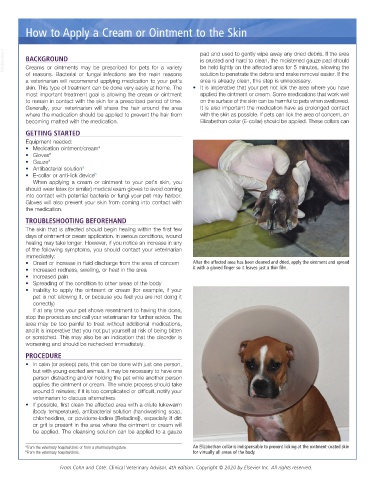Page 3157 - Cote clinical veterinary advisor dogs and cats 4th
P. 3157
How to Apply a Cream or Ointment to the Skin
VetBooks.ir BACKGROUND pad and used to gently wipe away any dried debris. If the area
is crusted and hard to clean, the moistened gauze pad should
be held lightly on the affected area for 5 minutes, allowing the
Creams or ointments may be prescribed for pets for a variety
of reasons. Bacterial or fungal infections are the main reasons solution to penetrate the debris and make removal easier. If the
a veterinarian will recommend applying medication to your pet’s area is already clean, this step is unnecessary.
skin. This type of treatment can be done very easily at home. The • It is imperative that your pet not lick the area where you have
most important treatment goal is allowing the cream or ointment applied the ointment or cream. Some medications that work well
to remain in contact with the skin for a prescribed period of time. on the surface of the skin can be harmful to pets when swallowed.
Generally, your veterinarian will shave the hair around the area It is also important the medication have as prolonged contact
where the medication should be applied to prevent the hair from with the skin as possible. If pets can lick the area of concern, an
becoming matted with the medication. Elizabethan collar (E-collar) should be applied. These collars can
GETTING STARTED
Equipment needed:
• Medication ointment/cream a
• Gloves a
• Gauze a
• Antibacterial solution a
• E-collar or anti-lick device b
When applying a cream or ointment to your pet’s skin, you
should wear latex (or similar) medical exam gloves to avoid coming
into contact with potential bacteria or fungi your pet may harbor.
Gloves will also prevent your skin from coming into contact with
the medication.
TROUBLESHOOTING BEFOREHAND
The skin that is affected should begin healing within the first few
days of ointment or cream application. In serious conditions, wound
healing may take longer. However, if you notice an increase in any
of the following symptoms, you should contact your veterinarian
immediately:
• Onset or increase in fluid discharge from the area of concern After the affected area has been cleaned and dried, apply the ointment and spread
• Increased redness, swelling, or heat in the area it with a gloved finger so it leaves just a thin film.
• Increased pain
• Spreading of the condition to other areas of the body
• Inability to apply the ointment or cream (for example, if your
pet is not allowing it, or because you feel you are not doing it
correctly)
If at any time your pet shows resentment to having this done,
stop the procedure and call your veterinarian for further advice. The
area may be too painful to treat without additional medications,
and it is imperative that you not put yourself at risk of being bitten
or scratched. This may also be an indication that the disorder is
worsening and should be rechecked immediately.
PROCEDURE
• In calm (or asleep) pets, this can be done with just one person,
but with young excited animals, it may be necessary to have one
person distracting and/or holding the pet while another person
applies the ointment or cream. The whole process should take
around 5 minutes; if it is too complicated or difficult, notify your
veterinarian to discuss alternatives.
• If possible, first clean the affected area with a dilute lukewarm
(body temperature), antibacterial solution (handwashing soap,
chlorhexidine, or povidone-iodine [Betadine]), especially if dirt
or grit is present in the area where the ointment or cream will
be applied. The cleansing solution can be applied to a gauze
a From the veterinary hospital/clinic or from a pharmacy/drugstore. An Elizabethan collar is indispensable to prevent licking at the ointment-coated skin
b From the veterinary hospital/clinic. for virtually all areas of the body.
From Cohn and Côté: Clinical Veterinary Advisor, 4th edition. Copyright © 2020 by Elsevier Inc. All rights reserved.

